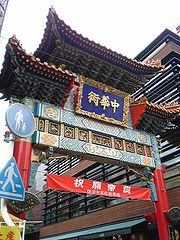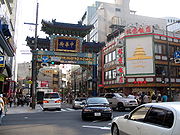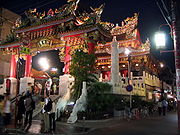
Yokohama Chinatown
Encyclopedia



Yokohama
is the capital city of Kanagawa Prefecture and the second largest city in Japan by population after Tokyo and most populous municipality of Japan. It lies on Tokyo Bay, south of Tokyo, in the Kantō region of the main island of Honshu...
, Japan
Japan
Japan is an island nation in East Asia. Located in the Pacific Ocean, it lies to the east of the Sea of Japan, China, North Korea, South Korea and Russia, stretching from the Sea of Okhotsk in the north to the East China Sea and Taiwan in the south...
, which is located just south of Tokyo
Tokyo
, ; officially , is one of the 47 prefectures of Japan. Tokyo is the capital of Japan, the center of the Greater Tokyo Area, and the largest metropolitan area of Japan. It is the seat of the Japanese government and the Imperial Palace, and the home of the Japanese Imperial Family...
. Its history is about 150 years long. Today only a few Chinese
Han Chinese
Han Chinese are an ethnic group native to China and are the largest single ethnic group in the world.Han Chinese constitute about 92% of the population of the People's Republic of China , 98% of the population of the Republic of China , 78% of the population of Singapore, and about 20% of the...
people still live in Chinatown
Chinatown
A Chinatown is an ethnic enclave of overseas Chinese people, although it is often generalized to include various Southeast Asian people. Chinatowns exist throughout the world, including East Asia, Southeast Asia, the Americas, Australasia, and Europe. Binondo's Chinatown located in Manila,...
, but it has a population of about 3,000 to 4,000. Most of the residents are from Guangzhou (Canton)
Guangzhou
Guangzhou , known historically as Canton or Kwangchow, is the capital and largest city of the Guangdong province in the People's Republic of China. Located in southern China on the Pearl River, about north-northwest of Hong Kong, Guangzhou is a key national transportation hub and trading port...
but many come from other regions.
Yokohama Chinatown is the largest Chinatown not only in Japan but also in Asia (larger than Chinatowns in both Kobe
Kobe
, pronounced , is the fifth-largest city in Japan and is the capital city of Hyōgo Prefecture on the southern side of the main island of Honshū, approximately west of Osaka...
and Nagasaki) and it is one of the largest in the world. There are roughly 250 chinese-owned/themed shops and restaurants scattered throughout the district, with the highest concentration centered around a 300 square metre area.
History
In 1859, when the sea port opened in Yokohama, many Chinese immigrants arrived in Japan and formed settlements. Later, ferry services between Yokohama and ShanghaiShanghai
Shanghai is the largest city by population in China and the largest city proper in the world. It is one of the four province-level municipalities in the People's Republic of China, with a total population of over 23 million as of 2010...
and Hong Kong
Hong Kong
Hong Kong is one of two Special Administrative Regions of the People's Republic of China , the other being Macau. A city-state situated on China's south coast and enclosed by the Pearl River Delta and South China Sea, it is renowned for its expansive skyline and deep natural harbour...
were started. Many Chinese traders came to Japan and built a Chinese School, Chinese Community Center, and various other facilities in what represented the beginning of Chinatown. However, government regulations at the time meant that immigrants were not permitted to live outside of the designated foreign settlement area. In 1899, changing laws gave Chinese increased freedom of movement while reinforcing strict rules on the types of work Chinese people were allowed to carry out.
In 1923, the Kanto Area was devastated by the Great Kanto Earthquake
1923 Great Kanto earthquake
The struck the Kantō plain on the Japanese main island of Honshū at 11:58:44 am JST on September 1, 1923. Varied accounts hold that the duration of the earthquake was between 4 and 10 minutes...
. Around 100,000 people were killed and approximately 1.9 million people became homeless. Chinatown also suffered and with many immigrants choosing to return to China instead of rebuilding their livelihoods in Yokohama.
In 1937, full-scale war between China and Japan
Second Sino-Japanese War
The Second Sino-Japanese War was a military conflict fought primarily between the Republic of China and the Empire of Japan. From 1937 to 1941, China fought Japan with some economic help from Germany , the Soviet Union and the United States...
erupted, effectively stopping further growth of Chinatown.
After the war ended, Chinatown once again began to grow. In 1955, a goodwill big gate was built. That is when the Chinatown was officially recognized and called Yokohama Chukagai (Yokohama Chinatown).
In 1972, Japan established diplomatic relations with People's Republic of China
People's Republic of China
China , officially the People's Republic of China , is the most populous country in the world, with over 1.3 billion citizens. Located in East Asia, the country covers approximately 9.6 million square kilometres...
, and severed relations with the Republic of China
Republic of China
The Republic of China , commonly known as Taiwan , is a unitary sovereign state located in East Asia. Originally based in mainland China, the Republic of China currently governs the island of Taiwan , which forms over 99% of its current territory, as well as Penghu, Kinmen, Matsu and other minor...
on Taiwan and interest amongst Japanese people grew leading to an explosion in the number of visitors to Chinatown with it becoming a major sightseeing spot in Yokohama.
On February 1, 2004, the Minatomirai Line railway was opened including the Motomachi-Chūkagai Station
Motomachi-Chukagai Station
is an underground terminus of the Minatomirai Line subway located in Naka-ku, Yokohama, Kanagawa Prefecture, Japan. It is 4.1 kilometers from the opposite terminus of the Minatomirai Line at Yokohama Station. Its official name, as shown on signage in the station, is with the sub-name in...
station, which serves Chinatown directly.
Train
- Minatomirai Line, Motomachi-Chūkagai StationMotomachi-Chukagai Stationis an underground terminus of the Minatomirai Line subway located in Naka-ku, Yokohama, Kanagawa Prefecture, Japan. It is 4.1 kilometers from the opposite terminus of the Minatomirai Line at Yokohama Station. Its official name, as shown on signage in the station, is with the sub-name in...
(35 min from Shibuya StationShibuya Stationis a train station located in Shibuya, Tokyo, Japan. With 2.4 million passengers on an average weekday in 2004, it is the fourth-busiest commuter rail station in Japan handling a large amount of commuter traffic between the center city and suburbs to the south and west.-JR East:*Saikyō Line /...
in Tokyo) - Negishi LineKeihin-Tohoku LineThe , is a railway line in Japan which connects the cities of Saitama, Kawaguchi, Tokyo, Kawasaki, and Yokohama. It is part of the East Japan Railway Company network. The line's name is derived from the characters for , and the...
, Ishikawachō StationIshikawacho Stationis a railway station operated by JR East's Negishi Line located in Naka-ku, Yokohama, Japan. It is 3.8 kilometers from the terminus of the Negishi Line at Yokohama Station and 62.9 kilometers from the terminus of the Keihin-Tōhoku Line at Ōmiya Station.-History:...
(50 min from Shinagawa StationShinagawa Stationis the first major station south ofTokyo Station and is a major interchange for trains operated by JR East, JR Central, and Keikyu. The Tōkaidō Shinkansen and other trains to the Miura Peninsula, Izu Peninsula and the Tōkai region pass through here...
in Tokyo)
Bus
There are 6 bus routes from Yokohama StationYokohama Station
is a main interchange station located in Nishi-ku, Yokohama, Japan. It is the busiest station in Kanagawa Prefecture and the 5th busiest in Japan as of 2004, serving 2.05 million passengers daily.-Lines:Yokohama Station is served by the following lines:...
East bus depot and from Sakuragichō
Sakuragicho Station
, is a railway station located in Naka Ward, Yokohama, Japan.-Lines:Sakuragichō Station is served by the following lines.*East Japan Railway Company**Keihin-Tōhoku Line / Negishi Line*Yokohama Municipal Subway**Blue Line -Station layout:...
Bus Depot, 16 bus routes that go to Yokohama Chinatown.
Highway
- Shuto ExpresswayShuto Expresswayis a network of toll expressways in the Greater Tokyo Area of Japan. It is operated and maintained by the .Most routes consist of elevated roadway above other roads or over water, and have many sharp curves which require caution to drive safely...
K1 Yokohane Route, Yokohama Kōen (Yokohama Park) Exit - Shuto Expressway K3 Kariba Route. (At Tomei Expressway Intersection, go Hodogaya Bypass then exit at Shin Yamashita.)
- Shuto Expressway Wangan Line (Via Tokyo Bay Aqua Line Tunnel, Exit at Shin Yamashita.)
- Tomei ExpresswayTomei ExpresswayThe is a national expressway on the island of Honshū in Japan. It is operated by Central Nippon Expressway Company. It is a part of Asian Highway Network -Naming:The word Tōmei is an acronym consisting of two kanji characters...
(Via Hodogaya Bypass)
See also
- Chinatowns in AsiaChinatowns in AsiaChinatowns in Asia are widespread with a large concentration of overseas Chinese in East Asia and Southeast Asia and ethnic Chinese whose ancestors came from southern China - particularly the provinces of Guangdong, Fujian, and Hainan - and settled in countries such as Brunei, Cambodia, Indonesia,...
- Kobe ChinatownKobe ChinatownKobe Chinatown is located in Kobe, Japan. One of only 3 designated Chinatowns in Japan, Nankinmachi is situated south of Motomachi station adjacent to the elegant Daimaru Department Store. This small, yet lively enclave is home to not only one of the few remaining Chinese communities in the...
- Nagasaki ChinatownNagasaki ChinatownNagasaki Chinatown is located in Nagasaki, Japan. This area today is a big shopping strip that covers many blocks.-History:...
- Kobe Chinatown
- Chinese in Japan
- ChinaChinaChinese civilization may refer to:* China for more general discussion of the country.* Chinese culture* Greater China, the transnational community of ethnic Chinese.* History of China* Sinosphere, the area historically affected by Chinese culture...
- Koreatowns in Japan

